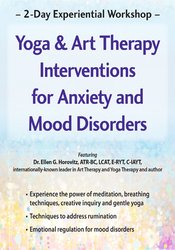

Are you feeling challenged or stuck with your clients? Need new ways to help them combat negative self-talk, mood disorders, and physiological challenges?
By combining yoga and art therapy techniques you will discover new and innovative ways to help your clients reduce physiological manifestations and mood disorders and replace rumination with healthy behaviors and thinking.
Watch Ellen, international speaker, author, expert art therapist and yoga therapist, to experience firsthand how to combine creative arts, present moment awareness, yoga, and self-compassion with your clients to calm worried minds and soothe painful emotions.
This exploration, rich in didactic and experiential practice, will teach you how to create a safe container, increase mood regulation in your clients and use specific strategies through:
Open the creative pathway for transformation and learn how to calm your central nervous system through yoga and witness your experience through creative artistic exploration.
You will leave this recording personally restored and confident in your ability to lead your clients towards creative expression, greater peace, transformation and mood regulation.
This online program is worth 12.25 hours CPD.
| File type | File name | Number of pages | |
|---|---|---|---|
| Manual - Yoga & Art Therapy Interventions (54.80 MB) | 119 Pages | Available after Purchase |
Mood Disorders
Case studies
Physiological Dysfunction
Case studies:
Satisfaction Guarantee
Your satisfaction is our goal and our guarantee. Concerns should be addressed to info@pesi.co.uk or call 01235847393.
Please wait ...